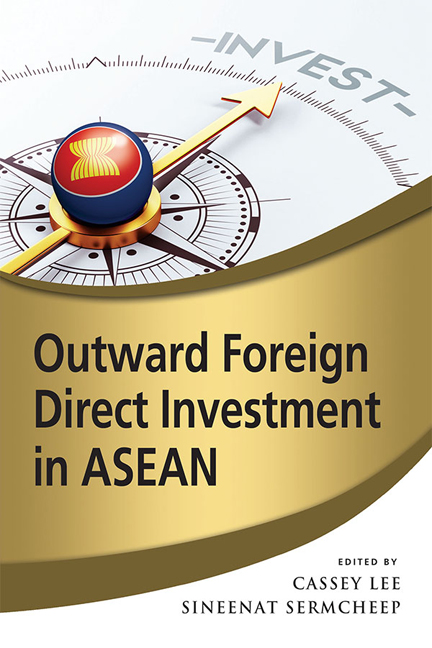Book contents
- Frontmatter
- Contents
- List of Tables
- List of Figures
- Foreword
- About the Contributors
- Introduction
- 1 The Rise of Outward Foreign Direct Investment from ASEAN
- 2 ASEAN's Outward Foreign Direct Investment
- 3 The Impact of the ASEAN Economic Community on Outward FDI in ASEAN Countries
- 4 Determinants of Singapore's Outward FDI
- 5 Outward Foreign Direct Investment from Malaysia
- 6 Indonesia's Outward Foreign Direct Investment
- 7 Factors Influencing Thailand's Outward FDI
- 8 Outward Foreign Direct Investment: The Case of Vietnam
- 9 Myanmar as a Destination for OFDI: A New ASEAN Foreign Investment Frontier
- Index
5 - Outward Foreign Direct Investment from Malaysia
Published online by Cambridge University Press: 19 May 2017
- Frontmatter
- Contents
- List of Tables
- List of Figures
- Foreword
- About the Contributors
- Introduction
- 1 The Rise of Outward Foreign Direct Investment from ASEAN
- 2 ASEAN's Outward Foreign Direct Investment
- 3 The Impact of the ASEAN Economic Community on Outward FDI in ASEAN Countries
- 4 Determinants of Singapore's Outward FDI
- 5 Outward Foreign Direct Investment from Malaysia
- 6 Indonesia's Outward Foreign Direct Investment
- 7 Factors Influencing Thailand's Outward FDI
- 8 Outward Foreign Direct Investment: The Case of Vietnam
- 9 Myanmar as a Destination for OFDI: A New ASEAN Foreign Investment Frontier
- Index
Summary
INTRODUCTION
Outward foreign direct investment (OFDI) from developing countries has progressively attracted research attention due to its increasing share in world outward flows. According to UNCTAD (2006a), only six developing and transition economies reported outward stocks of more than US$5 billion in 1990. By 2005, 25 developing and transition economies have exceeded that threshold, while contributing to 17 per cent of world outward flows. Malaysia is one of the contributors to this phenomenon. In 1980, Malaysia was ranked 11 in the top 15 developing and transition economies in terms of stocks of OFDI, but it moved up to the tenth position by 2013 (UNCTADSTAT 2014). OFDI in terms of flows surpassed inward flows after 2007, and Malaysia became a net capital exporter.
These changes inevitably lead to comparisons between OFDI from developed and developing economies. Based on the investment development path (IDP) theory, there are five stages of development whereby a country transits from being a net recipient of investment flows to becoming a net source of foreign direct investment (FDI). The first stage is characterized by little inflows and outflows as the country may not have acquired the necessary location-specific advantages to attract inflows, except for given endowments such as natural resources. The firms in the country are also at a nascent stage of development and therefore do not have as yet the firm-specific advantages and resources for investing abroad. In the second stage, inflows start to emerge with the development of location-specific advantages such as increases in per capita income. By the third stage, however, inward flows may start to decline due to erosion of some location-specific advantages such as low labour costs and the increasing competitiveness of local firms as they move up their learning path and acquire firm-specific advantages. Outward stock of FDI may equal or exceed inward stock by the fourth stage, while in the fifth stage, the net investment position hovers around zero with inward and outward stocks tending to be of the same magnitude.
- Type
- Chapter
- Information
- Outward Foreign Direct Investment in ASEAN , pp. 103 - 127Publisher: ISEAS–Yusof Ishak InstitutePrint publication year: 2017

